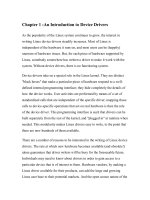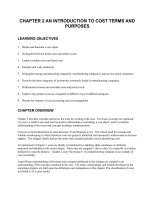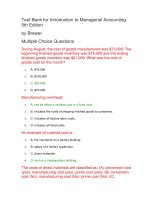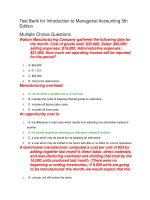Chapter 1 An Introduction to Managerial Accounting and Cost Concepts pot
Bạn đang xem bản rút gọn của tài liệu. Xem và tải ngay bản đầy đủ của tài liệu tại đây (673.5 KB, 70 trang )
Chapter 1
Chapter 1
An Introduction to
Managerial Accounting
and Cost Concepts
Work of Management
Planning
Planning
Controlling
Controlling
Directing and
Motivating
Directing and
Motivating
Planning
Identify
alternatives.
Identify
alternatives.
Select alternative that does
the best job of furthering
organization’s objectives.
Select alternative that does
the best job of furthering
organization’s objectives.
Develop budgets to guide
progress toward the
selected alternative.
Develop budgets to guide
progress toward the
selected alternative.
Directing and Motivating
Directing and Motivating
Directing and motivating involves managing
day-to-day activities to keep the
organization running smoothly.
Employee work assignments.
Routine problem solving.
Conflict resolution.
Effective communications.
Controlling
The control function ensures
that plans are being followed.
The control function ensures
that plans are being followed.
Feedback in the form of performance reports
that compare actual results with the budget
are an essential part of the control function.
Feedback in the form of performance reports
that compare actual results with the budget
are an essential part of the control function.
Planning and Control Cycle
Decision
Making
Formulating long-
and short-term plans
(Planning)
Formulating long-
and short-term plans
(Planning)
Measuring
performance
(Controlling)
Measuring
performance
(Controlling)
Implementing
plans (Directing
and Motivating)
Implementing
plans (Directing
and Motivating)
Comparing actual
to planned
performance
(Controlling)
Comparing actual
to planned
performance
(Controlling)
Begin
Comparison of Financial and Managerial
Accounting
Learning Objective
To identify and give
examples of each of the
three basic
manufacturing cost
categories
LO1
LO1
The Product
The Product
Direct
Materials
Direct
Materials
Direct
Labor
Direct
Labor
Manufacturing
Overhead
Manufacturing
Overhead
Manufacturing Costs
Direct Materials
Raw materials that become an integral part of
the product and that can be conveniently
traced directly to it.
Example: A radio installed in an automobile
Example: A radio installed in an automobile
Direct Labor
Those labor costs that can be easily traced to
individual units of product.
Example: Wages paid to automobile assembly workers
Example: Wages paid to automobile assembly workers
Manufacturing Overhead
Manufacturing costs that cannot be traced directly to
specific units produced.
Examples: Indirect materials and indirect labor
Examples: Indirect materials and indirect labor
Wages paid to employees
who are not directly
involved in production
work.
Examples: maintenance
workers, janitors and
security guards.
Materials used to support
the production process.
Examples: lubricants and
cleaning supplies used in the
automobile assembly plant.
Classifications of Costs
Direct
Material
Direct
Material
Direct
Labor
Direct
Labor
Manufacturing
Overhead
Manufacturing
Overhead
Prime
Cost
Conversion
Cost
Manufacturing costs are often
classified as follows:
Non-manufacturing Costs
Selling Costs
Costs necessary to get
the order and deliver
the product.
Administrative
Costs
All executive,
organizational, and
clerical costs.
Learning Objective
To distinguish between
product costs and
period costs and give
examples of each
LO2
LO2
Product Costs Versus Period Costs
Expense
Income
Statement
Inventory
Cost of
Goods Sold
Balance
Sheet
Income
Statement
Sale
Product costs include
direct materials, direct
labor, and
manufacturing
overhead.
Period costs are not
included in product
costs. They are
expensed on the
income statement.
Balance Sheet
Balance Sheet
Current assets
and inventory
Current assets
and inventory
Product Costs
(manufacturing
costs)
Income
Statement
Income
Statement
Revenue
COGS
Gross profit
Expenses
Net income.
Revenue
COGS
Gross profit
Expenses
Net income.
When goods
are sold.
When goods
are sold.
as
incurred
Period Costs
(operating
expenses and
income taxes.)
as
incurred
Product Costs Versus Period Costs
Quick Check
Which of the following costs would be
considered a period rather than a product cost
in a manufacturing company?
A. Manufacturing equipment depreciation.
B. Property taxes on corporate headquarters.
C. Direct materials costs.
D. Electrical costs to light the production
facility.
E. Sales commissions.
Quick Check
Which of the following costs would be
considered a period rather than a product cost
in a manufacturing company?
A. Manufacturing equipment depreciation.
B. Property taxes on corporate headquarters.
C. Direct materials costs.
D. Electrical costs to light the production
facility.
E. Sales commissions.
Comparing Merchandising and
Manufacturing Activities
Merchandisers . . .
Buy finished goods.
Sell finished goods.
Manufacturers . . .
Buy raw materials.
Produce and sell
finished goods.
MegaLoMart
Raw materials - inventory on
hand and available for use.
Raw materials - inventory on
hand and available for use.
Work in
process -
partially
completed
goods.
Work in
process -
partially
completed
goods.
Finished
goods-
completed
goods awaiting
sale.
Finished
goods-
completed
goods awaiting
sale.
Inventories of a Manufacturing Business
Direct
materials
purchased
Materials
Warehouse
Finished
goods
Finished goods
Warehouse
Goods
sold
Direct
materials
used
Factory
Direct labor &
Manufacturing overhead
The Flow of Physical Goods
Direct
materials
purchased
Direct
materials
used
Cost of goods
manufactured
Cost of
Goods Sold
$$$
Materials
Inventory
$$$ $$$
Finished Goods
Inventory
$$$ $$$
Work in Process
Inventory
$$$ $$$
The Flow of Manufacturing Costs
Direct labor &
Manufacturing overhead
Balance Sheet
Merchandiser
Current assets
Cash
Receivables
Prepaid expenses
Merchandise
inventory
Manufacturer
Current Assets
Cash
Receivables
Prepaid Expenses
Inventories:
Raw Materials
Work in Process
Finished Goods
Merchandiser
Current assets
Cash
Receivables
Prepaid expenses
Merchandise
inventory
Manufacturer
Current Assets
Cash
Receivables
Prepaid Expenses
Inventories:
Raw Materials
Work in Process
Finished Goods
Balance Sheet
Partially complete
products – some
material, labor, or
overhead has been
added.
Completed products
awaiting sale.
Materials waiting to
be processed.









